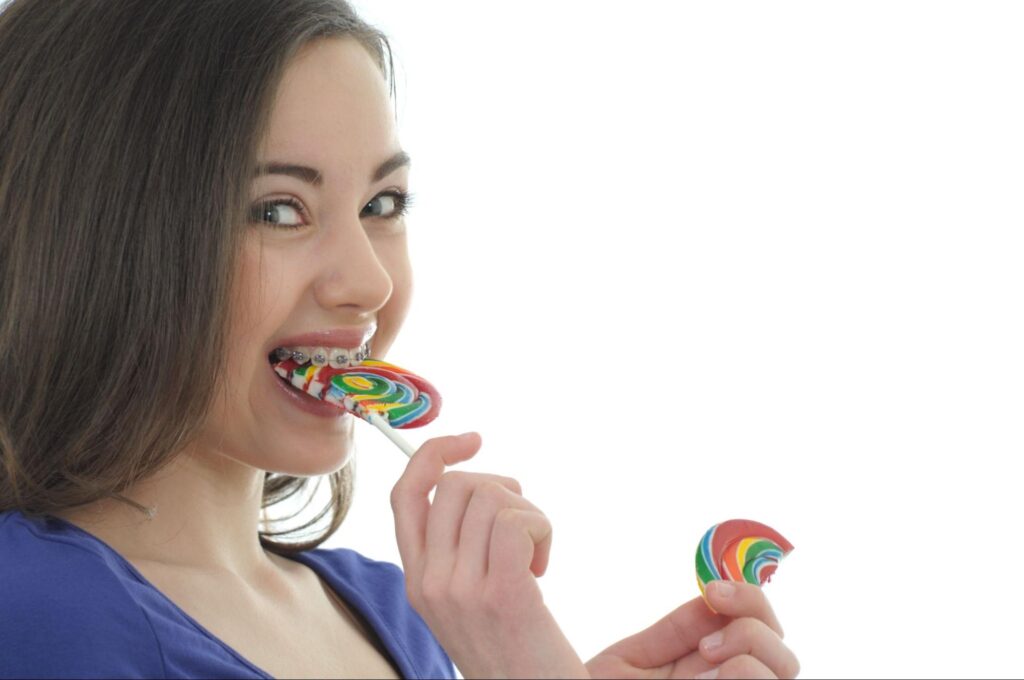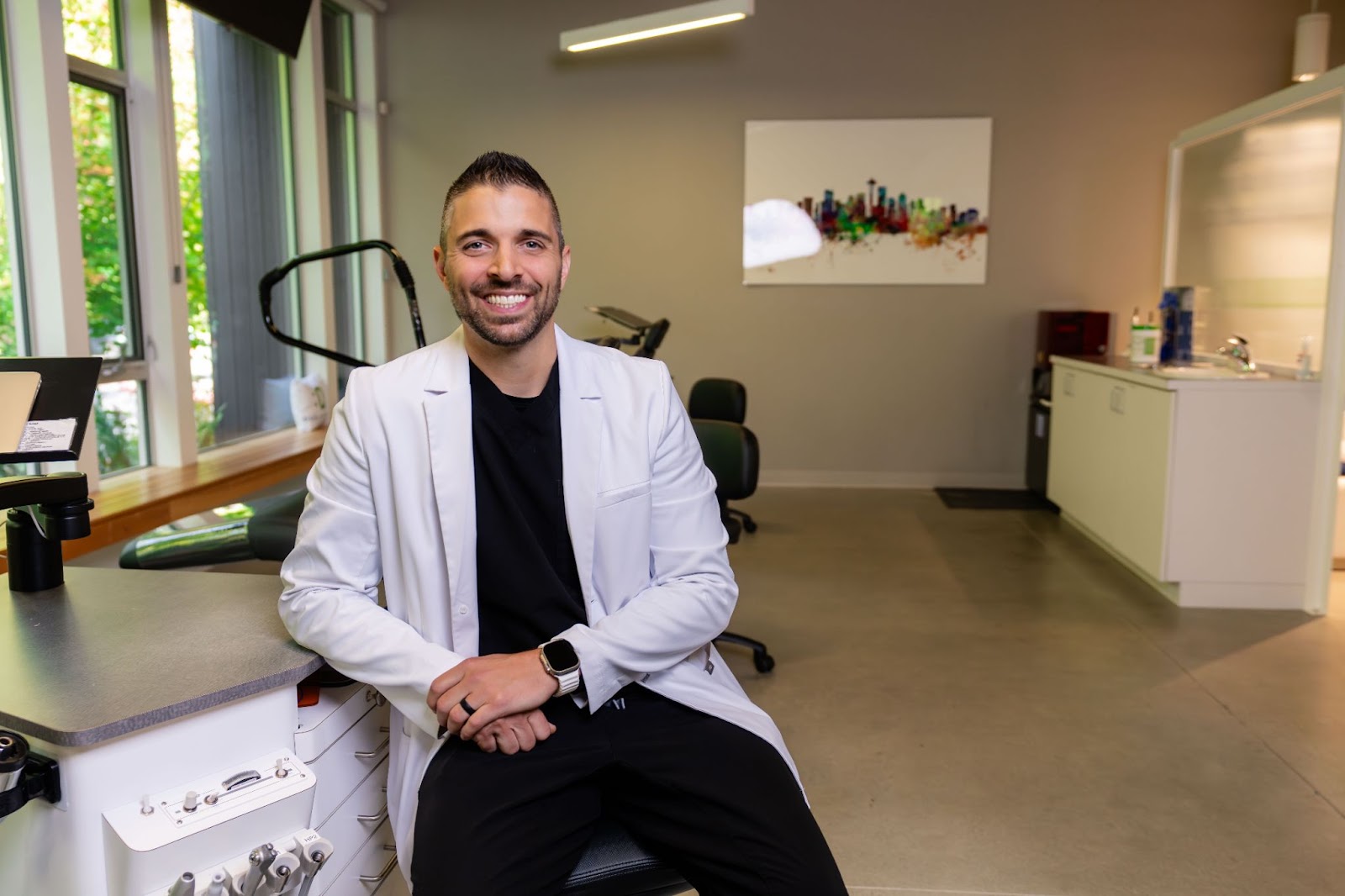When brushing gets overlooked, it can lead to gum irritation, stubborn plaque, and spots that don’t go away after the braces come off. Dr. Dudley sees the difference that daily habits make.
That’s why Dudley Smiles in Issaquah focuses on helping patients build routines that work, whether that means brushing at school, managing busy mornings, or finding the right tools to clean around brackets.
Why Clean Teeth Matter Even More With Braces
Braces make it a lot easier for food and bacteria to hang around longer than they should. Every bracket, wire, and band creates new angles where plaque can settle in. That plaque, if left behind, turns into acid that wears down enamel and irritates your gums. The trouble is, you might not see the damage right away. It builds over time, and when you get your braces off, you could notice white spots on your teeth.
That’s where brushing comes in. Consistent care keeps your teeth protected underneath the braces, so when they come off, you’re not left with white spots, cavities, or swollen gums. Those issues affect how your smile looks, and they can slow down treatment or lead to more dental work after your braces are off.
Clean teeth also help everything move more efficiently. When your gums are healthy and your enamel is strong, your braces can do their job without interruption. Brushing may feel repetitive, but it’s the one thing that helps you hold onto all the progress you’re making.
Follow These Tips for Brushing Braces
This part is important: brushing with braces needs to happen more often and a little more carefully than before. Aim for after every meal when possible, or at least three times a day. Here’s how to make each brushing count.
Start With a Rinse
If you can’t brush right after eating, rinse with water. Swishing helps loosen bits of food and makes brushing more effective when you get to it.
Use the Right Brush
A soft-bristled toothbrush or an electric one with a small head will help you clean around each bracket. If the bristles start to bend out, it’s time for a new brush, usually sooner than you’re used to.
Brush Every Angle
- Hold your brush at an angle above the brackets, then below them
- Use small circles and take your time, about 2–3 minutes total
- Don’t forget the gumline, the backs of your teeth, and the chewing surfaces
Finish Strong
Brush your tongue and the roof of your mouth, then rinse thoroughly. It helps reduce bacteria and freshens your breath, too.
Tools That Make Life Easier
Brushing and flossing can be time-consuming at first, but the right tools help speed things up without cutting corners.
- Electric toothbrush
- Floss threaders or orthodontic flossers
- Interdental brushes (small brushes that fit between wires)
- Fluoride mouthwash
All of these can make cleaning easier and more effective. If something’s not working for you, bring it up at your next appointment. Dr. Dudley and the team at Dudley Smiles can recommend tools that match your needs and schedule.
What About Flossing?
Now that you are aware of the tips for brushing braces, you should know flossing is just as important. Flossing around braces isn’t anyone’s favorite task, but it matters. Skipping it allows plaque to build up between your teeth, where your toothbrush can’t reach.
Try These Flossing Tips
Flossing with braces takes a little more patience than you’re probably used to, but it’s worth the effort. The wires and brackets create tight spaces that your toothbrush can’t reach, which makes flossing an important part of keeping your mouth healthy during treatment.
Threader floss or floss picks
Use these to get under the wire. Once the floss is in place, gently move it up and down between the teeth.
Be gentle
Don’t force anything or pull too hard, especially near the wires.
Be consistent
Even if it takes 10–15 minutes at first, it gets easier the more you do it.
Gums might bleed a little when you’re getting into the habit. That’s common, but if it keeps happening, mention it at your next visit.

Foods That Can Wreck Your Progress
Braces can handle a lot, but certain foods are off-limits for a reason. Hard, sticky, or extra chewy foods can pop brackets off or bend wires, setting your treatment back. Here’s a quick breakdown.
Avoid sticky foods like:
- Caramels
- Taffy
- Gummy candies
- Chewy granola bars
Skip hard items like:
- Ice
- Nuts
- Popcorn
- Crunchy chips
- Hard bread or pizza crust
Watch out for sugary snacks:
- Soda
- Sweet tea
- Candy
- Cookies and cakes
Too much sugar can feed the bacteria that cause plaque and cavities, especially when it gets trapped around brackets.
Small swaps make a big difference. If you’re craving something crunchy, try softer alternatives or cut things into bite-sized pieces so they’re easier on your braces.
Daily Habits That Keep Things on Track
These habits will help your treatment stay smooth:
- Brush at least 3 times a day
- Floss once a day (yes, even on busy nights)
- Use fluoride toothpaste and rinse with mouthwash
- Keep a travel toothbrush or flossers with you for school or work
- Replace brushes or brush heads more often than usual
Keeping up with these steps isn’t always fun, but it pays off when your braces come off and your smile is ready for the world.

Let Us Know If You Have Questions
If brushing feels frustrating or you’re second-guessing whether you’re doing enough, bring it up at your next appointment, and we can help with more tips for brushing braces. Dr. Dudley has seen it all, and the team at Dudley Smiles in Issaquah is happy to walk you through what works with no judgment and no stress. This is about making it easier, not perfect. Reach out, and we can help with any questions in between appointments.
